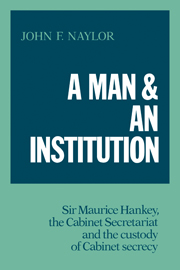 A Man and an Institution
A Man and an Institution Book contents
2 - The Lloyd George regime
Published online by Cambridge University Press: 30 March 2010
Summary
The fallen premier, H. H. Asquith, chose not to challenge in Parliament what his successor described as ‘the amalgamation of the old War Committee with the Cabinet.’ Nor did Asquith express more than his regret that the new regime had abandoned what he described as ‘the inflexible unwritten rule of the Cabinet,’ namely that the Prime Minister alone took a record of Cabinet proceedings, for the sole purpose of informing the King. In the wake of political crisis, near-universal approbation of the various administrative reforms followed; nor did the establishment of a Cabinet Secretariat loom particularly large in the redefinition of the relationship between Cabinet and Parliament, which was so far-ranging that A.J.P. Taylor has commented that ‘parliamentary government, as it had been known for the last century or so, ceased to exist.’ Nonetheless, Parliament deferred to Lloyd George's assurances, at least in part because Asquith tacitly acquiesced to the new premier's statement:
There seems to be a little concern that the new organisation should have the effect of lessening Parliamentary control. I wonder why on earth it should do that. Each Minister answers for his Department exactly in the same way as under the old system. Each Minister is accountable for his Department to Parliament, and the Government as a whole are accountable to Parliament.
While the Opposition Front Bench remained quiet – they had failed to win the war, after all – back-bench critics were not long in detecting a bureaucratic threat to representative government: linking together the two Secretariats they found ‘growing up round the War Cabinet a perfect fungus growth of liaison officers and paid secretaries of one kind or another.’
- Type
- Chapter
- Information
- A Man and an InstitutionSir Maurice Hankey, the Cabinet Secretariat and the Custody of Cabinet Secrecy, pp. 49 - 84Publisher: Cambridge University PressPrint publication year: 1984


